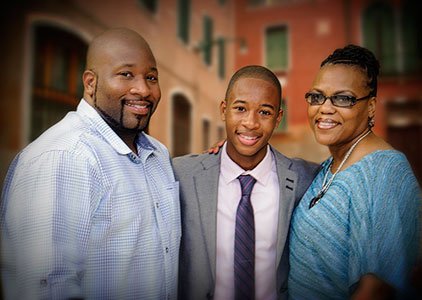BALTIMORE — Yolanda Horton, a breast cancer survivor who was diagnosed at the age of 42, recalled a movie outing she had with her 10-year-old son Rodney Horton, Jr.
“My beautician had made me a wig because my hair had fallen out from chemotherapy,” said Horton. “I had taken my son to the movies one day, and took off the wig to scratch my head. Afterwards, I asked my son if it bothered him. He told me, ‘you are beautiful with or without the wig. From that day on, I never wore the wig again.”
Horton credits this kind of love and support from her family and friends, along with her faith in God for helping her through her breast cancer journey.
“You are a survivor the moment you receive your diagnosis,” said Horton. “I thank God for my support system. My mom moved in with us the first year I was diagnosed. She also helped me through my cancer treatments. They all walked the journey with me. I thank God for the people he placed in my life to help me through.”
Horton is now 46. At the time of her diagnosis, she was a newlywed, and was working at the University of Maryland Medical Center as a co-facilitator for a breast cancer program. A nurse, she and her husband Rodney Horton had been married for just three months.
“It was a devastating blow,” said Horton. “I had just gotten married in June, and received the phone call regarding my results in August. When I received the call, I was shopping in Giant with my son. I had a jug of milk in my hand. I put down the milk, called my husband, and went home. I will never forget that moment.”
She added, “Being a healthcare professional, I know and understand the terminology. That knowledge was both good and bad, because I knew what would come. As the co-facilitator for a breast cancer program, I was a support for so many of my patients. Now, it was my turn to walk that journey. I understand that God guided me, because He knew I would need that knowledge.”
According to Horton, her journey began when she went in for a mammogram.
“I was called back because they saw some tissues that looked strange. As a nurse and a breast program coordinator, I knew to ask them to read my report. Ultimately, I received a biopsy, which showed benign breast cancer cells, which are a precursor to breast cancer. It is always recommended to get these cells removed, which I did.”
Horton said her surgical oncology breast surgeon did a right breast lumpectomy.
“She took the size of a lemon out of my left breast to make sure she got all the tissue. In taking such a wide margin, she discovered I had an invasive form of breast cancer. We had to discuss treatment plans from there.”
She added, “The amazing part was that by taking such a large margin she got the benign and breast cancer tissues. Looking at my previous mammogram, I saw the breast cancer tissue there, and it never changed. Had she not taken such a large margin, it may have been another two to three years before my cancer was discovered. I know it was only through God’s grace that it was discovered when it was.”
Horton said she had Triple Negative Breast Cancer. According to the National Breast Cancer Foundation, Inc., a diagnosis of triple negative breast cancer means that the three most common types of receptors known to fuel most breast cancer growth–estrogen, progesterone, and the HER-2/neu gene– are not present in the cancer tumor. This means that the breast cancer cells have tested negative for hormone epidermal growth factor receptor 2 (HER-2), estrogen receptors (ER), and progesterone receptors (PR). Since the tumor cells lack the necessary receptors, common treatments such as hormone therapy and drugs that target estrogen, progesterone, and HER-2 are ineffective.
“We had to see if the cancer had spread and then start chemotherapy for six months and radiation for six weeks,” said Horton.
Currently, Horton’s cancer is in remission.
“This year I celebrated my fourth ‘cancerversary’,” she said. “I know that God has more for me to do.”
She also has earned a master’s degree in Nursing, which she plans to use to help underserved communities. Horton shared this advice.
“People have to talk to their loves ones, especially their older family members about their family history. Genetics does matter. Preventative care is also key. Self-breast exams allow you to know if your breasts have changed, while mammograms and clinical breast exams are also necessary.”
She added, “A mammogram can detect a lump not detected by hand, which happened in my case. Without that mammogram, I could still have cancer. Women, as well as men, have to take care of themselves. Early detection is the key to survival for any disease.”
Horton highlighted the Baltimore City Cancer Program, which offers free breast cancer and cervical cancer screenings. For more information, visit http://www.umgcc.org/bccp
